Beyond Champagne: Unveiling the World of Sparkling Wine Choices
Every year I’m excited to come to Imbibe to see what’s happening at the forefront of the drinks industry. Right now, a lot of the media focus about drinks seems to be on the idea that Gen Zs aren’t drinking as much as the generations before them, and so the future of the drink’s biz is doomed. I don’t think it’s as bleak as that at all. There are loads of us across all generations who love and buy drinks, and the best thing about this moment in the drink’s world is the choice available to us. If Gen Zs aren’t buying alcohol, then there’s the amazing no-and-low category, and if they are, alcoholic drinks are better than ever. They’re more natural, more sustainable, more honest, and more ethical than ever before. And - away from Gen Zs all together - there are four other generations among us who really do love a drink.
The diversity of choice is something I’ll be exploring in my session, Spotlight on Sparkling Wine. In the past, “bubbles” pretty much meant Champagne, but the category is expansive and encompasses many different types of sparkling wine from a wide range of regions, made using various methods and techniques. I’ll be sharing great examples of sparkling from Spain, Italy, England, and France.
A bottle of bubbly used to be a beverage for a special occasion; something to celebrate with. But things have changed. There’s now bubbles for every budget, enabling us to pop a bottle whenever the mood takes us. This casual bottle-popping culture has been the norm for centuries in places across Europe. For instance, Germany’s penchant for a couple of glasses of Sekt throughout the week has made them the biggest consumer of bubbles in the world. In the UK, we’re starting to adopt this lifestyle too and, alongside the United States, we’re one of the largest importers of sparkling wine, with around 13 million of us drinking it every month.
The great thing about sparkling wine is that it seems to work for any occasion. You can get dry or sweet sparkling wines; they can be crisp with high acidity, or fruity and soft. You might want something light and clean, or full-bodied and creamy. The versatility means that sparkling can be perfect for many different situations, from brunch to lunch, to an after-work drink, pre-dinner, or post-dinner (and throughout dinner, too). Birthdays, festive days, and any days, really, all call for something sparkling.
But just because we drink it more, it doesn’t mean sparkling wine has lost its shine. The sound of a popping cork is always special, and bubbles seem to have a magical way of energising people and lifting the mood.
In my session at the Tasting Room, we’ll be tasting a Cava, an English Sparkling Wine, Prosecco Superiore DOCG and petillant naturel (pet nat). These wines are made differently from each other, using different methods and grape varieties. We’ll explore how location changes the taste of a wine, as well as the impact that culture and history have on its style. Cava, for example, is really interesting to look at because of its reputation in the UK as a budget bubbly. Because of our exposure to cheap bottom shelf Cava, many of us haven’t been aware of how nuanced and refined real, artisanal Cava can be. Made in the same way as Champagne, but with grapes local to Catalonia, you’ll experience some of the bready-biscuity flavours you get from traditional method lees ageing, alongside melon, pear and citrus flavours and floral aromatics. Even at the premium level, good quality Cava offers incredible value for money.
There is a whole world of sparkling wine and it’s an exciting place to be right now. Let’s get some corks popping.
Enjoy this article? Make sure to share it!
Looking for something else?
